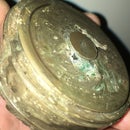Introduction: The Sands of Time
I would say this will make an interesting project because- it incorporates both, the aspects of Craft and Science. It also represents and celebrates a commodity that is more precious then Platinum. This is >TIME< - time seems to just simply slips through our fingers.
We have many many ways in which we measure it and a plethora of devices which have been made to calibrate it - but nature was the first. The sun rises in the East and sets in the West and we have of course the seasons. - A rule of thumb / rough calculation, if the sun is right above your head, it must be around 12 O Clock.
Time is a paradox in it's self - we value it and in the same breath, squander it....
In this instructable you will be making a time piece from antiquity itself .......
Step 1: Tools and Materials
A Junior Hacksaw (fine blade). A wood working vice or soft jaws. A small round file. Screw driver (small/Flat) Araldite + Shiny piece of Cardboard. A Fine Sieve / Tea Strainer. Beach Sand. 22mm by 22mm piece of dowel or broom handle. 10-12mm dowel 18"in length. 4"(101.6mm) by 20(4) Bayonet Fit - Clear LightBulbs - Drill & Stand - Mini Lathe - 8mm drill - Garden Twine -Medium Sand-Paper Varnish/ Lacquer. Safety Equip;-) Glasses and Gloves.....
Step 2: Preparing the Glass Bulb (Stage 1)
Being very curious about how things are made, I one day decided to take a lightbulb apart, there was a purpose to this as I will explain later. Over the years we have created and refined, sometimes you cannot see how. If you have a dud lightbulb in your basement - garage or angle poise lamp and it is a clear glass type, compare it to a new off the shelf one......! You will be amazed at how much smaller and thinner it is.
Preparation of Glass Bulb....Opening you vise about 20mm - place / Straddle the Bayonet in between the opening whilst holding the bulb end with gloves. Then gently apply pressure with hacksaw -cutting until the blade hits the glass inside - rotate clockwise until you have cut the circumference leaving a ring as shown by the diagram.
Step 3: Glass Prep Continued (Stage 2)
You should now be left with a ring still attached to the bulb with the bottom part very loose - hanging by wires. Now twist until bottom section breaks off.
Now you will see the exposed valve or glass nipple holding the gas and the filament in place..... BE Very Careful and diligent !!! Wearing goggles and using you screwdriver to wedge between the Central nipple and outer glass shell until you fracture it letting the gas out. It's will sound like a deflating tire. Be careful if you are too forceful you may destroy or chip the main chamber. If there are any imperfection is put into the glass discard and start again.
Step 4: Glass Prep (stage 3)
Once the gas is released as shown in step (1) . We now want to follow step (2) goggles should be worn throughout this process as shards are dangerous. We now have to gently tap inside like a woodpecker with our screw driver to fracture around the filament base-To detach it from the main chamber. We need to preserve as much glass inside the ring as possible and get a round enough aperture at the same time - as this determines the strength of the glass chamber. Now the filament should break free from the main Chamber --We now should have a hole like in our [1st] diagram at the bottom, marked [Step-2]. We may need to make this hole slightly bigger so when we turn it upside down all the debris falls out or can be pulled out [Very Very Carefully] Later on we have to taylor the size of aperture for our Funnel.....
Step 5: Coupling & Timing Funnel
The next stage is to make the coupling between the two bulbs as this has two purposes//// [1] Coupling the two bulbs together and [2] Timing/Dispersal of the media inside.....Media We can use SIO2 [Sand] Or Soda Lime [Glass] .If using Sand we need to wash the sand in a jam jar give a minute to settle then pour out water and repeat until water is clean. Now we leave to dry on a radiator, once dried we need a uniform grain size. For this we need a sieve, and we end up with a grain size of .030 - .050". This should be ample.
Timing: from the picture above we see that the hole/ aperture we made in the bulbs must butt up to the ring on the base opening and fit inside the hole.............
Using you own judgement as bulbs come in all different sizes & are not quite as generic as they look. All I can advise is the funnel should not be too tight or you risk breaking the glass..... Timing....If this instructable is for timing an egg I would aim for 4-5 mins -This can be achieved by filling up a bulb with your desired media and grain size and placing the funnel inside the bulbs aperture. Holding in place with one hand and a Stop-Watch in the other, turn upside down and time!! Obviously the bigger your hole the faster it will empty the smaller the hole the slower it will empty. Too small a hole with course media may block up!! The think of the Salt pot in your local Greasy Spoon.
When you are happy with you timming we now have to glue our funnel to the aperture of >1< filled bulb!!!
The reason is because the media will fall out otherwise. Areldite if perfect but get the glassware type which is clear!! Once this is dry Areldite the opposit step of the funnel and place Empty Bulb butting it up in-line you may have to rotate bulb in situ, until your happy.
When the glue is tacky you may wish put liberal coat of glue to completely seal from moiture and even wrap garden twine around both rings whilst still wet.
Step 6: Making Frame for the Bulbs
Here's some basic geometry to help you make the template for the top and bottom part of the frame. Taking a 4" [101.6mm] [1] square piece of paper fold in half - [2] then bring a corner to the centre and fold a diagonal line holding a corner then folding oposite corner to the centre line/fold . Now take opposite corner and line up with top edge of diagonal and fold to make the 60o angle of an equilateral triangle.. You should now have an equilateral triangle but with a short corner this is intentional [Kind of] we are going to use this corner a s a template for our other corner as follows. This corner is a 90o angle we are going to make it a Quadrant like drawing a circle inside a aquare. Once this is accomplised we will fold our trangle in half then trace our quadrant. If we then open up our trangle we shall then rorate 120o fold in half again and repeat then trace of our quadrant like in the image above......... Feel free to use a compass if this step seems odd :-)
Step 7: Using Our Template and Some Construction
The wood I used was around 18MM or 3/4" you will need to use your judgement here as we have to make a 10mm deep dish/ bowl and around 40mm +/- diameter to suit our BULBS it is really about trial and error, as I have mentioned the bulbs come in all shapes and sizes and are not quite generic as you think - >like clothes pegs<. As a rule of thumb the angled corners of our triangular bases need to be bigger then the diameter of our bulbs plus the diameter of our DOWEL PILLARS
/////The pillars- Its is far easier to buy some 10-12mm dowel but I had a lathe at my disposal, so I thought why not and made some from a plank used for shelving it was heavy /and had a nice pine aroma and not like the cheap quality you buy nowdays. I also like to recycle if possible..... Moving on!!! Once the bowl in the top and base have been made -we take our Constructed Glassware with media inside. We sit it on a base and then take the other base and place it on top. // Now we have to measure whilst roughly holding it all together and parallel [the inside distance between top and bottom]........We then mark the dowel with this distance, adding 20mm....
Step 8: Realisation of Final Construcution
Measuring the larger diameter of our bulbs using a piece of paper-/////
Take a piece of paper roughly 10mm of A4 paper the long side [297mm] wrap around the circumference of the bulb and mark where they join like a taylor would measure a collar. Now divide into [3] and then half ONE of the pieces........You now have, more or less the distance you need to open you compass in-order to draw a circle on each of the wooden bases.
From this there should be enough room to place our dowels without compromising (splitting) the edges of our bases.
Using the original template we now have to find the centres for drilling the holes on our angled edges. Once ascertained, Drill [3] holes One for each corner to [8]mm Diameter and 10mm deep. Repeat proceedure for other base.....
Now taking our [3] Pieces of dowel push into drill holes [If they are tight Sand the ends until desired fir is achieved] Place constructed frame on a piece of paper and check it is all parallel and measure the distance. Compare length of glassware to inner distance of frame there should be slighly under 25.4mm [1"] +/- of total difference. now the glassware should be free but not too loose and should not be piched by the [3] Pillars.........
This is not an exact science, you will need to play around with the dimensions a little - I can definately say this is very much achievable as I have sold a few and made plenty.......ONCE you are happy with your construction glue with Areldite or any strong clear appoxy........
;-)This instructable is not for the faint hearted (-: However for anyone with patient this is a rewarding piece as it has function and can also just be a craft piece and decorated acordingly I one made one with Cobras Twisting from top to bottom....
Please Enjoy And Comment GOOD LUCK













